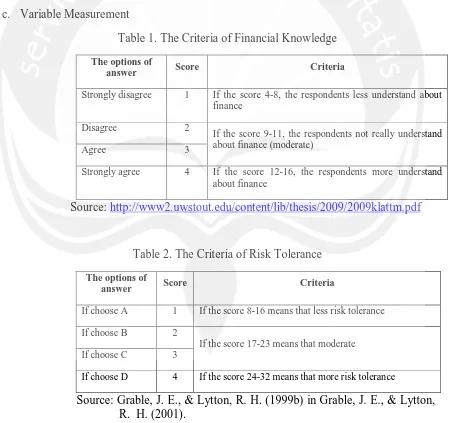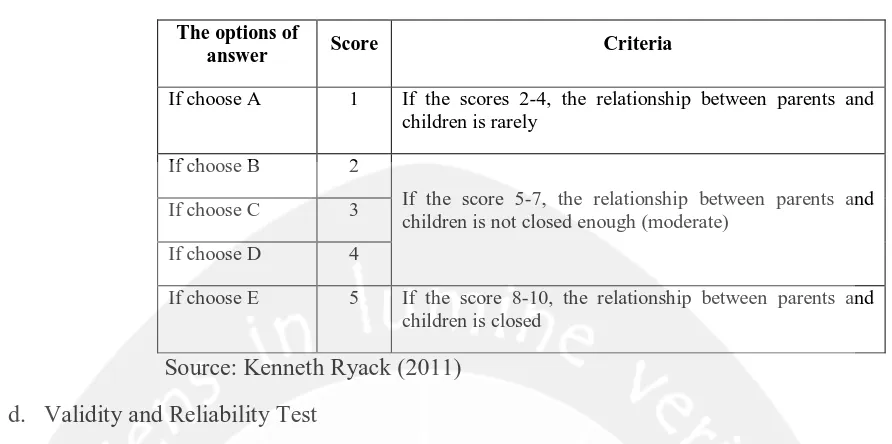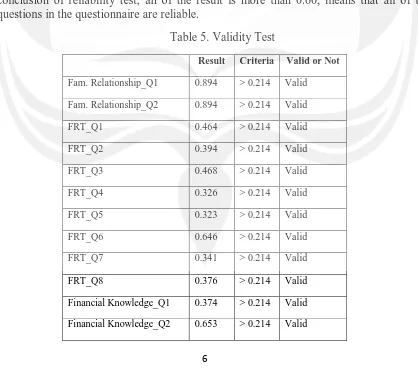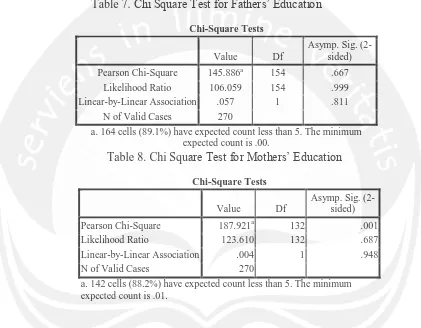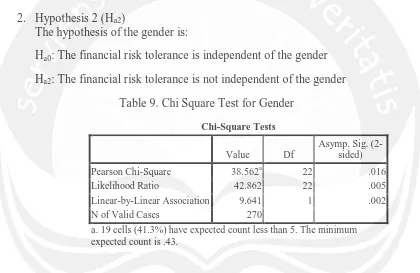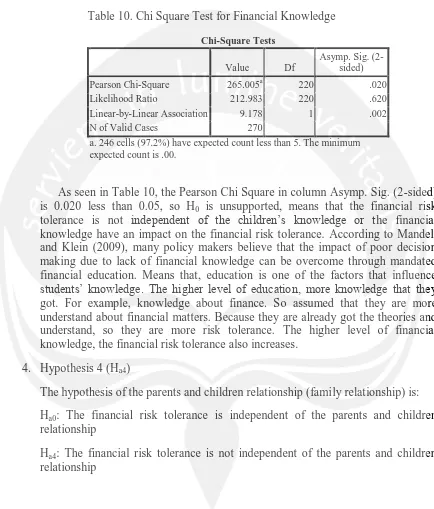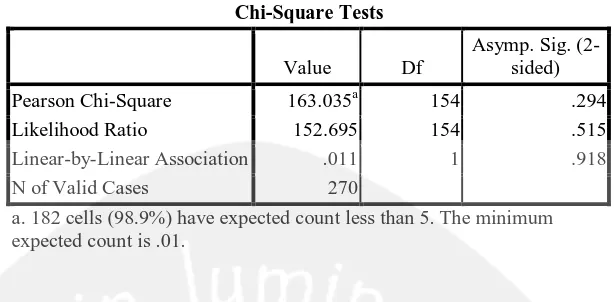1
THE IMPACT OF FAMILY RELATIONSHIP, GENDER, AND FINANCIAL KNOWLEDGE ON FINANCIAL RISK TOLERANCE
Karina Irene Purnamasari
Alexander Djatmiko Wibowo
Management Program, Faculty of Economics, Universitas Atma Jaya
Jalan Babarsari 43-44, Yogyakarta
ABSTRACT
This research is designed to analyze whether the family relationship, especially parents and children relationship, gender, and financial knowledge that respondents have whether could impact on financial risk tolerance. In this research, there are three independent variables that used to prove whether that three variables could impact the financial risk tolerance. The three independent variables there are family relationship, gender, and financial knowledge. The data in this research are primary data by using questionnaire and secondary data is the theories that used to support the explanation of this research. The total sample of this research is 270 respondents. Chi Square Test is used to test the hypotheses. The result of this research, there is no impact in family relationship on financial risk tolerance. Financial risk tolerance more easily affected by knowledge.
Keywords: family relationship, gender, financial knowledge, financial risk tolerance
I. INTRODUCTION
a. Background
2
their children’s decision. If the level of education of parents high, they could influence or
affect their children’s decisions more than parents who have low level of education.
Because if parents have high level of education, they have more knowledge, so they could give an advice or suggestion to their children, moreover if related with what their parents learned. But not always the relationship between parents and children could impact on financial risk tolerance. Because more mature peoples, the influence from outside like education and friends could make or change mindset and behavior.
Women generally more risk aversion than men. According to Binay K Adhikari
and Virginia O’Leary (2011), women demonstrated more risk aversion than men because they considered themselves to be less knowledgeable about financial markets. Even thought women have knowledge and ability equal with men, but most of women are still not confident with their ability. Because women are more conservative in make a decision in investing, usually broker offered less risky investments (Wang, 1994 in Adhikari and
O’Leary, 2011). Women who are conservative in their investment, means that they did
not want to get loss, so usually they also less risk tolerance.
Financial knowledge is the knowledge possessed and understanding about financial matters or financial concepts. Many researches have found the relationship between risk tolerance and formal levels of education. Individuals who have education, assumed that they have more knowledge and better understanding than individuals who have not knowledge. The individuals who already got enough theories, they could predict what would happen. So, individuals who had enough knowledge and understand about finance usually more risk tolerance. Individuals who had knowledge and understand about finance, usually have a better decision and healthy financial condition.
b. Problem Statements
Based on the research background, the problem statements are:
a. Can the parents’ education impact the financial risk tolerance of their children?
b. Can the gender impact the financial risk tolerance?
c. Can the children’s knowledge impact the financial risk tolerance?
d. Can the parents and children relationship impact the financial risk tolerance?
c. Objectives of Research
This research is designed to understand the impact of family relationship, financial knowledge, and gender on financial risk tolerance on the primary data.
The objective of this research is to testify several thing, they are:
a. The author would to analyze the impact of family relationships, between parents’ education and child, could impact their children, on financial risk tolerance.
3
c. The author would to analyze the financial knowledge could impact the financial risk tolerance.
II. THEORITICAL BACKGROUND
a. Family Relationship
Family is the smallest unit or group in society. From the family, all of basic lessons and basic knowledge begins. So, parents have a big influence to their children. If children and parents have a good relationship, then children are willing to accept the values and norms that socialized or give by parents. But, more mature children, they already have their own thinking, so the parents cannot intervention their children decision. The parents only could give an advice or suggestion, but the decision in their children, because they already their own thinking.
b. Financial Knowledge
Peoples who are in university level are assumed that have more knowledge than peoples who are in non university level. For example peoples in college who are concentrate in finance, would understand about investment than peoples who are in high school. Because peoples in college learned more specific and detail about finance, while peoples in high school learn about economic in general. So, peoples who are have better or higher education about finance, generally more risk tolerance because they already learned the theories.
c. Gender
Men generally are more risk taking than women. According to Wang, 1994 in Adhikari and O’Leary, 2011, stated that because women are more conservative in make a decision in investing, usually broker offered less risky investments. According to that statement, women are tend to risk aversion or they tend to choose low risk and have less confident than men.
d. Financial Risk Tolerance
Risk always related with return. The theory also said that high risk, high return. So, many people thought that if they choose high risk, they would get higher return. The willingness to accept risk in order to get higher return called financial risk tolerance.
III.HYPOTHESES
Based on the explanation above, the author developed hypotheses to be tested in this study as follow:
Ha1: The parents’ education impact the financial risk tolerance of their children
Ha2: There is the impact of gender on the financial risk tolerance
4
Ha4: There is the impact of parents and children relationship on the financial risk tolerance
IV.RESEARCH METHODOLOGY
a. Population and Sample
The population of this research is students at Atma Jaya University. The sample is the students at Atma Jaya University who already took financial management subject and the
respondent’s parents.
b. Data
For the main data, use questionnaires for the primary data. The author collected from the answer of respondents in the questionnaires. For the supporting data, the author got the information from internet, books, journals, and another sources. The supporting data used to support the explanation and to support the theories that are used.
c. Variable Measurement
Table 1. The Criteria of Financial Knowledge
The options of
answer Score Criteria
Strongly disagree 1 If the score 4-8, the respondents less understand about finance
Disagree 2
If the score 9-11, the respondents not really understand about finance (moderate)
Agree 3
Strongly agree 4 If the score 12-16, the respondents more understand about finance
Source: http://www2.uwstout.edu/content/lib/thesis/2009/2009klattm.pdf
Table 2. The Criteria of Risk Tolerance
The options of
answer Score Criteria
If choose A 1 If the score 8-16 means that less risk tolerance
If choose B 2
If the score 17-23 means that moderate
If choose C 3
If choose D 4 If the score 24-32 means that more risk tolerance
5
Table 3. The Criteria of Family Relationship
The options of
answer Score Criteria
If choose A 1 If the scores 2-4, the relationship between parents and children is rarely
If choose B 2
If the score 5-7, the relationship between parents and children is not closed enough (moderate)
If choose C 3
If choose D 4
If choose E 5 If the score 8-10, the relationship between parents and children is closed
Source: Kenneth Ryack (2011)
d. Validity and Reliability Test
To measure the validity of the questionnaires, the author uses the result in column
“Corrected Item Total Correlation”. If the result in column “Corrected Item Total Correlation” are more than r table, means that the instrument are valid. To compare the result of “Corrected Items Total Correlation” and the r table, whereas df = n-2 with the significant level 5% (0.05) (Sujarweni, 2007).
To measure the reliability of the questioner, the author uses internal consistency method based on coefficient of Cronbach’s Alpha. If the value of reliability > 0.60, means the instrument that be used is reliable.
e. Method of Analysis
Descriptive statistics is to give general description about the data or the demographic information. Chi-square test is to analyze whether the family relationship, gender, and financial knowledge could impact the financial risk tolerance. The hypotheses for chi-square test are:
Ha0: The children’s financial risk tolerance is independent of the parents’ education
Ha1: The children’s financial risk tolerance is not independent of the parents’ education Ha0: The financial risk tolerance is independent of the gender
Ha2: The financial risk tolerance is not independent of the gender
Ha0: The financial risk tolerance is independent of the children’s knowledge Ha3: The financial risk tolerance is not independent of the children’s knowledge
Ha0: The financial risk tolerance is independent of the parents and children relationship
Ha4: The financial risk tolerance is not independent of the parents and children relationship
6
If the probability > 0.05, H0 is supported
If probability < 0.05, H0 is unsupported
V. DATA ANALYSIS
a. Reliability and Validity Testing
Table 4. Reliability Test
Result Criteria Reliable or Not
Family Relationship 0.943 > 0.60 Reliable
Financial Risk Tolerance 0.721 > 0.60 Reliable
Financial Knowledge 0.760 > 0.60 Reliable
From the total questionnaires that already collected are 270, and 60 questionnaires used to test the validity and reliability the instrument. As seen in Table 4, the reliability testing of family relationship, the value of Cronbach’s Alpha is 0.943. The reliability testing of financial risk tolerance, the value of Cronbach’s Alpha is 0.721. The reliability testing of financial knowledge, the value of Cronbach’s Alpha is 0.760. So, the conclusion of reliability test, all of the result is more than 0.60, means that all of the questions in the questionnaire are reliable.
Table 5. Validity Test
Result Criteria Valid or Not
Fam. Relationship_Q1 0.894 > 0.214 Valid
Fam. Relationship_Q2 0.894 > 0.214 Valid
FRT_Q1 0.464 > 0.214 Valid
FRT_Q2 0.394 > 0.214 Valid
FRT_Q3 0.468 > 0.214 Valid
FRT_Q4 0.326 > 0.214 Valid
FRT_Q5 0.323 > 0.214 Valid
FRT_Q6 0.646 > 0.214 Valid
FRT_Q7 0.341 > 0.214 Valid
FRT_Q8 0.376 > 0.214 Valid
Financial Knowledge_Q1 0.374 > 0.214 Valid
7
Financial Knowledge_Q3 0.690 > 0.214 Valid
Financial Knowledge_Q4 0.558 > 0.214 Valid
For the validity testing of family relationship, there are two questions about family relationship. For the validity of financial risk tolerance, there are eight questions about financial risk tolerance. For the validity testing of financial knowledge, there are four questions about financial knowledge. As seen in Table 5, the value for each question about family relationship is 0.894 for Q1 and 0.894 for Q2. The value for each question about financial risk tolerance is 0.464 for Q1, 0.394 for Q2, 0.468 for Q3, 0.326 for Q4, 0.323 for Q5, 0.646 for Q6, 0.341 for Q7, and 0.376 for Q8. The value for each question about financial knowledge is 0.374 for Q1, 0.653 for Q2, 0.690 for Q3, and 0.558 for Q4. So, the conclusion of validity test, all of the results is more than 0.214, means that all of the questions in the questionnaire are valid. So, the conclusion from the reliability and validity test in this research is all of the questions in the questionnaires are valid and reliable.
b. Descriptive Statistics
Table 6. Descriptive Statistics
N Percent (%)
N Percent (%)
Gender: Fathers’ Occupation:
Men 116 43.0 Unemployed 5 1.9
Women 154 57.0 Labor 5 1.9
Major: Employee 45 16.7
Management 163 60.4 PNS 46 17.0
Accounting 94 34.8 Educator (Lecturer or
teacher)
15 5.6
IE 13 4.8 Doctor or nurse 5 1.9
Financial subject that already took:
Entrepreneur 113 41.9
1 course 17 6.3 Manager and professional 17 6.3
2 courses 64 23.7 Trader 19 7.0
3Courses 58 21.5 Mothers’ Occupation:
More than 3 courses 131 48.5 Unemployed 96 35.6
Fathers’ Last Education: Labor 0 0
No degree 1 0.4 Employee 17 6.3
8
Junior high school 16 5.9 Educator (Lecturer or
teacher)
18 6.7
Senior high school 74 27.4 Doctor or nurse 8 3.0
D3 2 0.7 Entrepreneur 65 24.1
S1 143 53.0 Manager and professional 7 2.6
S2 21 7.8 Trader 25 9.3
S3 9 3.3
Mothers’ Last Education:
No degree 0 0
Elementary school 10 3.7
Junior high school 25 9.3
Senior high school 81 30.0
D3 19 7.0
S1 125 46.3
S2 8 3.0
S3 2 0.7
As seen in Table 6, descriptive statistic based on gender, the respondents consist of 116 men or 43% and 154 women or 57%. So the majority respondents who filled the questionnaires are women. Students who are interest with finance or who already took the financial courses, most of them are women or female students. For the descriptive statistic based on major consist of 163 persons from management or 60.4%, 94 persons from accounting or 43.8%, and 13 persons from IE or 4.8%. So, the most of respondents who filled the questionnaires are from management. The most of respondents are from management because in management, there is financial major and respondents who are concentrate in finance are the priority. For the descriptive statistic based on financial subject consist of 17 respondents who already took one course or 6.3%, 64 respondents who already took 2 courses or 23.7%, 58 respondents who already took 3 courses or 21.5%, and 131 respondents who already took more than 3 courses or 48.5%. So, the majority respondents are already took more than three courses about financial subject. As explained before that the priority is students who are concentrate in finance. Students or respondents who are concentrate in finance, at least already took three courses about finance, financial management course in third semester, advance financial management course in forth semester, and one elective course about finance. Fro the descriptive
statistic about parents’ last education, both of father and mother’s last education are
bachelor degree. For descriptive statistic based on parents’ occupation, most of
9
c. Hypotheses Testing
1. Hypothesis 1 (Ha1)
The hypothesis of the parents’ education is:
Ha0: The children’s financial risk tolerance is independent of the parents’ education
Ha1: The children’s financial risk tolerance is not independent of the parents’ education
Table 7. Chi Square Test for Fathers’ Education
Chi-Square Tests
Value Df
Asymp. Sig. (2-sided)
Pearson Chi-Square 145.886a 154 .667
Likelihood Ratio 106.059 154 .999
Linear-by-Linear Association .057 1 .811
N of Valid Cases 270
a. 164 cells (89.1%) have expected count less than 5. The minimum expected count is .00.
Table 8. Chi Square Test for Mothers’ Education
Chi-Square Tests
Value Df
Asymp. Sig. (2-sided)
Pearson Chi-Square 187.921a 132 .001
Likelihood Ratio 123.610 132 .687
Linear-by-Linear Association .004 1 .948
N of Valid Cases 270
a. 142 cells (88.2%) have expected count less than 5. The minimum expected count is .01.
As seen in Table 7, the Pearson Chi Square of fathers’ education in column Asymp. Sig is 0.667, more than 0.05, so H0 is supported, means that the children’s financial risk tolerance is independent or the fathers’ education are not impact on the financial risk tolerance of their children, while the Pearson Chi Square of
mothers’ education in column Asymp. Sig is 0.001 (Table 8) less than 0.05, so H0
is unsupported, means that the children’s financial risk tolerance is not
independent of the parents’ education or the mothers’ education are impact on the financial risk tolerance of their children. According to Ermisch and Pronzato
(2010), parents’ educational attainments have a large impact on their earnings and they may alter the “productivity” of their time investments in children, such as
reading to the child, and they may affect children’s aspiration, which means that the higher of parents’ education, the higher income that received. Reading to the
child, usually mothers who are read the book for children while fathers usually
they busy with their work. Mothers’ education has the impact on the financial risk
10
questionnaires, most of them are unemployed or housewife. Because of that, the mothers have more time with their children. So, if the relationship is closed, children are willing to accept the values and norms that socialized by the parents.
The education of parents also could impact to their occupation. Means that with higher level of education of parents, they could got better job, than parents who are had lower level of education or even no school. Peoples or parents who have higher level of education, assumed that have more knowledge. Job that has higher salary, usually job that need higher knowledge and higher skill. Because job that has high salary, usually peoples work with their brain, while job that has low salary, usually peoples work with their muscles. The result of the
respondents’ parents, both of father and mother, there are significant, 0.000, is less
than 0.05, so the parents’ education could impact on the parents’ occupation. The conclusion from the parents’ education and parents’ occupation is with higher
level of education, they could get better job and could get better salary.
2. Hypothesis 2 (Ha2)
The hypothesis of the gender is:
Ha0: The financial risk tolerance is independent of the gender
Ha2: The financial risk tolerance is not independent of the gender Table 9. Chi Square Test for Gender
Chi-Square Tests
Value Df
Asymp. Sig. (2-sided)
Pearson Chi-Square 38.562a 22 .016
Likelihood Ratio 42.862 22 .005
Linear-by-Linear Association 9.641 1 .002
N of Valid Cases 270
a. 19 cells (41.3%) have expected count less than 5. The minimum expected count is .43.
The Pearson Chi Square in column Asymp. Sig is 0.016 (Table 9) less than 0.05, so H0 is unsupported, means that the financial risk tolerance is not independent of the gender. So, there is an impact of gender on the financial risk tolerance. According to Jianakoplos and Bernasek (1998), also explain that women are more risk aversion in financial decision making than men, for example, women and men are difference in the allocation of their money or asset and the longevity of the investment. Men are tends to more risk taking than women. For the longevity, usually women are tends to take longer investment than men. According to Deaux and Emswiller (1994) and Beyer and Bowden (1997) in
11
3. Hypothesis 3 (Ha3)
The hypothesis of the financial knowledge is:
Ha0: The financial risk tolerance is independent of the children’s knowledge
Ha3: The financial risk tolerance is not independent of the children’s knowledge
Table 10. Chi Square Test for Financial Knowledge
Chi-Square Tests
Value Df
Asymp. Sig. (2-sided)
Pearson Chi-Square 265.005a 220 .020
Likelihood Ratio 212.983 220 .620
Linear-by-Linear Association 9.178 1 .002
N of Valid Cases 270
a. 246 cells (97.2%) have expected count less than 5. The minimum expected count is .00.
As seen in Table 10, the Pearson Chi Square in column Asymp. Sig. (2-sided) is 0.020 less than 0.05, so H0 is unsupported, means that the financial risk tolerance is not independent of the children’s knowledge or the financial knowledge have an impact on the financial risk tolerance. According to Mandell and Klein (2009), many policy makers believe that the impact of poor decision making due to lack of financial knowledge can be overcome through mandated financial education. Means that, education is one of the factors that influence
students’ knowledge. The higher level of education, more knowledge that they
got. For example, knowledge about finance. So assumed that they are more understand about financial matters. Because they are already got the theories and understand, so they are more risk tolerance. The higher level of financial knowledge, the financial risk tolerance also increases.
4. Hypothesis 4 (Ha4)
The hypothesis of the parents and children relationship (family relationship) is: Ha0: The financial risk tolerance is independent of the parents and children relationship
12
Table 11. Chi Square Test for Family Relationship
Chi-Square Tests
Value Df
Asymp. Sig. (2-sided)
Pearson Chi-Square 163.035a 154 .294
Likelihood Ratio 152.695 154 .515
Linear-by-Linear Association .011 1 .918
N of Valid Cases 270
a. 182 cells (98.9%) have expected count less than 5. The minimum expected count is .01.
As seen in Table 11, the Pearson Chi Square in column Asymp. Sig is 0.294 more than 0.05, so H0 is supported, means that the financial risk tolerance is independent of the parents and children relationship or there is no impact of the family relationship on the financial risk tolerance. As explained previously, because there are many influence from outside, like friends and education, the children could change their behavior and mindset. More mature children, they also have own thinking, so the parents cannot intervention their children’s decision. The parents only could give an advice or suggestion, but who decided the decision is their children. According to the Kenneth Ryack (2011), there is no significant relationship is found between the financial risk tolerance of the children and the parents, means that there is no relationship between parents and children on the financial risk tolerance. The amount of time the children report that their parents had spent teaching them about financial matters also does not appear to impact their financial risk tolerance (Kenneth Ryack, 2011). So the relationship between parents and children does not guarantee that parents could influence the risk tolerance of their children.
VI.CONCLUSION AND SUGGESTION
a. Conclusion
The financial risk tolerance every people are difference. The factors that influence the financial risk tolerance every people also difference one and another. In this research, the author wants to prove whether family relationship, gender, and financial knowledge could impact on the financial risk tolerance. The conclusion of this research derived from the hypothesis testing to answer the problem statement:
1. The hypothesis 1 (Ha1) which state that parents’ education impact on the financial risk tolerance of their children. In this variable, divided into two analyses. First is fathers’
education, and second is mothers’ education. For the fathers’ education, H01 is supported. Means that, the financial risk tolerance of the children is independent of
the parents’ education or the fathers’ education has no impact on the financial risk
tolerance of their children. For the mothers’ education, H01 is unsupported. Means that, the financial risk tolerance of the children is not independent of the parents’
education or the mothers’ education has an impact on the financial risk tolerance. So,
13
2. The hypothesis 2 (Ha2) which state that there is the impact of gender on the financial risk tolerance, H02 is unsupported. So the alternative or Ha2 is supported, means that the financial risk tolerance is not independent of the gender or there is the impact of gender on the financial risk tolerance.
3. The hypothesis 3 (Ha3) which state that there is the impact of children’s knowledge on the financial risk tolerance, H03 is unsupported. So the alternative or Ha3 is supported, means that the financial risk tolerance is not independent of the children’s knowledge or the financial knowledge have an impact on the financial risk tolerance.
4. The hypothesis 4 (Ha4) which state that there is the impact of parents and children relationship on the financial risk tolerance, H04 is supported. Means that, the financial risk tolerance is independent to the parents and children relationship or there is no impact of the family relationship on the financial risk tolerance.
In general, the conclusions are gender and children’s knowledge is not independent or has an impact on the financial risk tolerance. The parents’ education and the parents and children relationship (family relationship) are independent or have no impact on the financial risk tolerance.
b. Limitation of the Research
The limitation in this research are in family relationship only analyze the relationship between children and parents, the spousal relationship is not analyzed. For the respondents, the author only distribute the questionnaires for the respondents who already took financial course, at least one course, because respondents who already took financial course assumed understand about financial matters and would be easy to answer the questions. In parents section, the question only the demographic information such as occupation and last education of the parents. The hypothesis testing used in this research is Chi Square.
c. Suggestion
14
BIBLIOGRAPHY
Adhikari, B. K. and O’Leary, Virginia. (2011), “Gender Differences in Risk Aversion: A Developing Nation’s Case”, Journal of Personal Finance, Vol. 10, No. 2.
Barnasek, A. and Shwiff, S. (2001), “Gender, Risk, and Retirement”, Journal of Economic Issues, Vol. 35, No. 2, pp. 345.
Chan, S. F., Chau, A. Wai-Lap., and Chan, K. Yin-Kwan. (2012), “Financial Knowledge
and Aptitudes: Impacts on College Students’ Financial Well-Being”, College Student Journal, Vol. 46, No. 1.
Chinen, K. and Endo, Hideki. (2012), “Effects of Attitude and Background on Personal
Financial Ability: A Student Survey in the United States”, International Journal of Management, Vol. 29, No. 1.
Cornett, M. M., Adair, T. A, Jr., and Nofsinger, J. (2009), Finance: Applications and
Theory, The McGraw-Hill Companies, Inc., New York.
Damodaran, A. (2008), Strategic Risk Taking: A Framework for Risk Management, Pearson Education, Inc.
Ermisch, J. and Pronzato, C. (2010), “Causal Effects of Parents’ Education on Children’s Education”, Economic and Social Research Council, No. 16.
Fisher, P. J. (2010), “Gender Differences in Personal Saving Behaviors”, Journal of Financial Counseling and Planning, Vol. 21.
Gilliam, J. E., Goetz, J. W. and Hampton, V. L. (2008), “Spousal Differences in Financial
Risk Tolerance”, Journal of Financial Counseling and Planning, Vol. 19.
Goksel, I. (2013), “The Influence of Maternal Employment on Children’s Long Run Achievement: Case of Izmir”, Anadolu International Conference, No. 156.
Grable, J. E. and Lytton, R. H. (2001), “Assessing The Concurrent Validity of The SCF
Risk Tolerance Question”, Journal of Financial Counseling and Planning, Vol. 12(2).
Harrington, S. E. and Niehaus, G. R. 2003. Risk Management & Insurance. McGraw-Hill.
http://dictionary.reference.com/browse/family.
http://financial-dictionary.thefreedictionary.com/Risk+Tolerance.
http://id.wikipedia.org/wiki/Keluarga.
http://web.worldbank.org/WBSITE/EXTERNAL/TOPICS/EXTGENDER/0,,contentMD K:20193040~pagePK:210058~piPK:210062~theSitePK:336868,00.html.
15
http://www.investopedia.com/terms/s/strategic-financial-management.asp.
http://www.who.int/gender/whatisgender/en/
Jacobs-Lawson, J. M. and Hershey, D. A. (2005), “Influence of Future Time Perspective, Financial Knowledge, and Financial Risk Tolerance on Retirement Saving
Behaviors”, Financial Services Review, Vol. 14(4), pp. 331-344.
Jianakoplos, N. A. and Barnasek, A. (1998), “Are Women More Risk Averse?”, Economic Inquiry, Vol. 36, No. 4, pp. 620-630.
Jones, C. P. (2010), Investments: Principles and Concepts, Eleventh Edition, John Wiley & Sons Ltd., United Kingdom.
Klatt, M. E. (2009), “An Assessement of Women’s Financial Literacy”, Available at: http://www2.uwstout.edu/content/lib/thesis/2009/2009klattm.pdf, University of Wisconsin-Stout, United States. Accessed on December 2009.
Lam, J., (2003), Enterprise Risk Management: From Incentives to Controls, John Wiley & Sons, Inc., New Jersey.
Mandell, L. and Klein, L. S. (2009), “The Impact of Financial Literacy Education on
Subsequent Financial Behavior”, Journal of Financial Counseling and Planning, Vol. 20.
Ryack, K. (2011), “The Impact of Family Relationships and Financial Education on Financial Risk Tolerance”, Financial Services Review, Vol. 20, No. 3, pp. 181.
Sekaran, Uma. and Bougie, Roger. (2009), Research Methods for Business: A Skill Building Approach, Fifth Edition, John Wily & Sons Ltd., United Kingdom.
Sujarweni, V. W. (2007), Belajar Mudah SPSSS untuk Penelitian Skripsi, Thesis, Disertasi & Umum, Global Media Informasi, Yogyakarta.
Tavakol, M. and Dennick, R. (2011), “Making Sense of Cronbach’s Alpha”, International Journal of Medical Education.
Tjondrowidjojo, E. K. 2013. Behavioral Finance Study toward Credit Card Holders.
